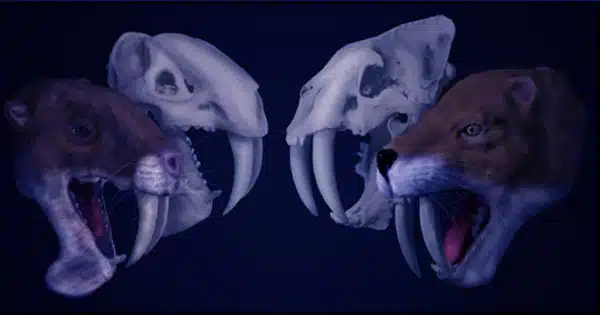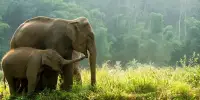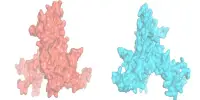Using teeth so big they stretched across the top of its cranium, an ancient carnivorous marsupial cousin with wide-set eyes like a bovine or a horse could stalk successfully, according to new research. Carnivores’ forward-facing eye sockets, or orbits, contribute to the ability to see in three dimensions, which is a helpful trait for determining the location of food before pouncing. The “marsupial sabertooth” Thylacosmilus atrox was examined by researchers from the American Museum of Natural History and the Instituto Argentino de Nivologa, Glaciologa y Ciencias Ambientales in Mendoza, Argentina. Their findings were released in the journal Communications Biology today.
Thylacosmilus, which was extinct in South America about 3 million years ago, was referred to as the “marsupial (or metatherian) sabertooth” because of its incredibly big top teeth, which resemble those of the more renowned placental sabertooth that developed in North America. It belonged to the Sparassodonta suborder of extremely carnivorous animals, which includes extinct marsupials. The majority of sparassodont species resembled placental predators like cats and dogs in having forward-facing eyes and, presumably, complete 3D vision. However, sparassodont species varied greatly in size—Thylacosmilus may have weighted as much as 100 kilograms (220 pounds)—and the species varied greatly in size. As a hypercarnivore, or an animal whose food is thought to contain at least 70% meat, Thylacosmilus’ orbits were positioned more like those of ungulates, with orbits that face mostly horizontally.Thylacosmilus, which was extinct in South America about 3 million years ago, was referred to as the “marsupial (or metatherian) sabertooth” because of its incredibly big top teeth, which resemble those of the more renowned placental sabertooth that developed in North America. It belonged to the Sparassodonta suborder of extremely carnivorous animals, which includes extinct marsupials. The majority of sparassodont species resembled placental predators like cats and dogs in having forward-facing eyes and, presumably, complete 3D vision. However, sparassodont species varied greatly in size—Thylacosmilus may have weighted as much as 100 kilograms (220 pounds)—and the species varied greatly in size. As a hypercarnivore, or an animal whose food is thought to contain at least 70% meat, Thylacosmilus’ orbits were positioned more like those of ungulates, with orbits that face mostly horizontally. The visual regions do not adequately intersect in this instance for the brain to combine them into three dimensions. What would cause a hypercarnivore to develop such an odd adaptation? In pursuit of an explanation, a group of scientists from the US and Argentina started out.

Lead author Charlène Gaillard, a candidate at the Instituto Argentino de Nivologa, Glaciologa y Ciencias Ambientales, said, “You can’t understand cranial organization in Thylacosmilus without first confronting those enormous canines.” (INAGLIA). “They weren’t just big; they were constantly expanding to the point where the canine roots extended over the summits of their heads. One result of this was that the orbits could not be placed in their typical carnivore location on the front of the snout.
Gaillard evaluated the orbital structure in a variety of extinct and contemporary animals using CT scanning and 3D virtual models. She was able to ascertain how Thylacosmilus’ visual system would have contrasted with that of other predators or animals in general. Thylacosmilus had an orbital convergence value as low as 35 degrees, compared to that of a normal hunter, like a cat, at around 65 degrees. Low orbital convergence does occur in some contemporary predators, but Thylacosmilus was exceptional in this respect.
However, the degree of frontation—a measurement of how the eyes are positioned within the orbits—also plays a role in excellent stereoscopic vision. Analia M. Forasiepi, a co-author from INAGLIA and a researcher at CONICET, the Argentinean science and research agency, explained that Thylacosmilus was able to increase visual field overlap as much as possible by sticking its orbits out somewhat and orienting them almost vertically. Although its orbits were not well suited for 3D vision, it was still able to attain a visual field overlap of about 70%, which was obviously sufficient for it to be an effective active predator.
According to Ross D. E. MacPhee, assistant curator at the American Museum of Natural History and study co-author, “Compensation appears to be the key to understanding how the skull of Thylacosmilus was put together.” The outcome we see in mature heads is actually the product of the canine growth pattern during early cranial development dislodging the orbits from the front of the face. The unusual orientation of the orbits in Thylacosmilus actually represents a morphological compromise between the cranium’s primary function of holding and protecting the brain and sense organs and a supplementary function that was specific to this species, namely to allow space for the development of the enormous canines.
Thylacosmilus evolved other cranial modifications in addition to lateral orbital displacement to fit its teeth while preserving other functions. Because they are so near to the temporal chewing muscles when the eyes are on the side of the cranium, feeding may cause deformation. Some animals, including monkeys, have evolved a bony structure that seals off the eye sockets from the side in order to compensate for this. Another instance of convergence among different species is what Thylacosmilus accomplished.
This raises the following concluding query: Why would the evolution of massive, continuously expanding canines necessitate re-engineering of the entire skull?
Gaillard remarked, “It might have made hunting simpler in some unfathomable manner, but if so, why didn’t any other sparassodont—or for that matter, any other mammalian carnivore—develop the same adaptation congruently? Unlike rats’ incisors, Thylacosmilus’ canines did not deteriorate over time. They merely appear to have kept expanding at the root, ultimately reaching almost the back of the cranium.
This was stressed by Forasiepi, who stated, “To search for clear-cut adaptive explanations in evolutionary biology is enjoyable but mainly futile. Thylacosmilus was not a freak of nature, but in its time and environment, it managed to live as an ambush predator, seemingly quite splendidly. Even though it defies our ingrained notions of what a good mammalian carnivore should appear like, evolution has its own laws, so we may regard it as an anomaly.
















